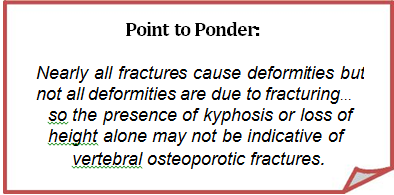Fractures in Osteoporosis
Fractures are one of the most serious clinical signs of osteoporosis as well as the clinical sequelae which has the most impact on a patient’s function, psychological well-being and life. As mentioned earlier 80% of hip fractures are osteoporosis-related. Hip fractures result in death in up to 20% of cases, and disability in 50% of those who survive.
An osteoporotic fracture is often referred to as a “fragility” fracture or “low-trauma” fracture. In general both of these are referring to a fracture resulting from a fall from standing height or equivalent degree of trauma. This can include: slipping on ice, tripping and falling, lifting something, coughing or sneezing. Often the term fragility fracture is interpreted to infer that the bones are particularly thin already, but a fracture resulting from a standing height fall can still cause a fracture in those who are just starting to lose bone density (osteopenic), so there seems to be a movement towards using the terminology ‘low-trauma’ fracture instead.
Usual sites of osteoporotic fractures include: ribs, wrist, spine, hip, and humerus. The reported lifetime fragility fracture risk is 1:2 for women; 1:8 for men.
Focus: Hip & Vertebral Fractures
It has been reported that over 90% of hip fractures in the elderly are as a result of a fall but interestingly only 5% of all falls actually result in a hip fracture.11 This suggests that it is not just the fall which causes a hip fracture and that there must be a fall characteristic, like point of contact or leg orientation which is the more important determinant of a fracture.25 Researchers have demonstrated that those people who fall to the side (onto the greater trochanter, for example) are 6-20 times more likely to sustain a fracture compared to other fallers.10,13 Other research using computer modeling has concluded that falling on the hip laterally with the leg internally rotated results in a high possibility of fracture as the femoral neck is weakest to a postero-lateral blow.14
While hip fractures are clearly most common as a result of falls, vertebral fractures are not as likely to arise from a fall, in fact only 1/3 result from falling.3 Vertebral fractures can arise from accidents or lifting heavy objects but nearly 60% are spontaneous and not related to a single incident or event. Thus vertebral fractures may occur incrementally and not catastrophically.
Osteoporotic fractures are nearly always end-plate fractures and thus results in a crush of the vertebral body (centrally or uniformly) or an anterior wedging of the vertebral body. The most clinically obvious result of vertebral fractures is a notable thoracic kyphosis or loss of height.

Interestingly, hip and vertebral fractures are related. Prevalent vertebral fractures significantly increase the risk of future hip fracture. Several studies, have demonstrated a 2-3 fold increase over a 10 year period in the relative risk of hip fracture for those osteoporosis patients with a prevalent vertebral fracture versus those with no previous vertebral fracture.1,12,15,19
